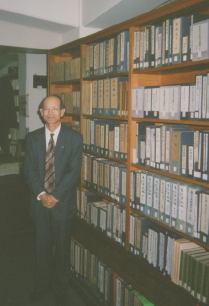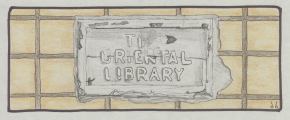Visit to The Toyo
Bunko
Once upon a time, back when I was a very little
boy, I was planning to be a jet pilot when I grew up. At some point
that idea faded away (perhaps because I had to start wearing glasses)
and I moved on to other dreams. I suppose, as with most children,
there were many of them during the years, more than I can now
remember ... but another one does stick in my mind; when I was a
grade seven student, I wanted to become a librarian. I still have
memories of staying after school to help the school librarian with
'chores' such as preparing catalogue cards for the new books, pasting
labels in them, and then arranging them in the proper places on the
shelves. Actually, I don't think it was the idea of being a librarian
that attracted me so much as the idea of working in a library. All
those books ... row after row of books ... Years later when I got my
first 'real' job, working in a music store, this dream came partially
true. One of my main tasks was organizing and maintaining order in a
vast mountain of music books that crammed a warehouse in a back
alley. It was the perfect job for me, and I did it very well indeed.
(I did it so well that I was soon promoted to 'higher' levels in the
company, where I doubt that I was quite so effective ...)
So it was then, that the preparation for this
story was especially interesting for me. One day this May Sadako-san
and I made a visit to the Toyo Bunko, the research library in
Bunkyo-ku here in Tokyo that owns the original copy of the Shunsho
'Hyaku-nin Isshu' book that I am reproducing. We were welcomed by Mr.
Isao Koyama, who has been my contact there during the years of my
work on this series, and who kindly took time to give us an overview
of this very interesting place.
 Unlike a 'normal' library, here no
books are visible when one first enters the large and mostly bare
reading room containing some old, rather spartan tables and chairs.
The visitors, mostly scholars and researchers, make requests to the
staff for the particular items they wish to see, and these are then
brought up to this room from their resting places deep within the
building. As I wrote in this newsletter some years ago, when I first
went to the Toyo Bunko I had not really expected to be allowed any
access to their collection. I was not an 'official' scholar, I had no
connections, no introduction ... just a rather scruffy bearded
foreigner in jeans. But for some reason Koyama-san decided to trust
me that day, and agreed to bring out the Shunsho book for my perusal.
I can still remember the apprehensive look on his face as I sat down
at one of the old tables and started to open it up. He must have
wondered - did I know how to handle such an old book? Would I smudge
the pages? Tear some of them? Was he making a big mistake?
Unlike a 'normal' library, here no
books are visible when one first enters the large and mostly bare
reading room containing some old, rather spartan tables and chairs.
The visitors, mostly scholars and researchers, make requests to the
staff for the particular items they wish to see, and these are then
brought up to this room from their resting places deep within the
building. As I wrote in this newsletter some years ago, when I first
went to the Toyo Bunko I had not really expected to be allowed any
access to their collection. I was not an 'official' scholar, I had no
connections, no introduction ... just a rather scruffy bearded
foreigner in jeans. But for some reason Koyama-san decided to trust
me that day, and agreed to bring out the Shunsho book for my perusal.
I can still remember the apprehensive look on his face as I sat down
at one of the old tables and started to open it up. He must have
wondered - did I know how to handle such an old book? Would I smudge
the pages? Tear some of them? Was he making a big mistake?
We laughed about that during this visit. Yes, he
admits that he hadn't felt so comfortable about handing me the book.
This is a constant dilemma for them: finding a balance between caring
for their treasures, and allowing them to be handled, studied and
used. Although I as a printmaker want to touch these books, feel the
soft washi under my fingers, and try and get close to the men who
made them, it is Koyama-san's responsibility to see that they are
passed on to future generations in the best condition possible, which
means that only a minimum of physical contact can be
permitted.
'His' collection is vast indeed. At present, more
than 800,000 items are cared for in this building; not only Edo-era
books like the ones in which I am interested, but volumes from Korea,
China and indeed from every part of Asia. The Toyo Bunko was
established about seventy years ago by Hisaya Iwasaki, a member of
the founding family of the Mitsubishi industrial group, who had
assembled a large collection of materials on Asia through purchase of
various private libraries, and then set up a foundation to make them
available to scholars. Since 1948, the collection has been part of
the National Diet Library.
Although I had not dared to ask if it was
possible, partway through our visit Koyama-san offered to take us
back into the 'stacks' to get a quick glimpse at the books
themselves. When we passed through the heavy door leading to the
storage areas, I found that it was not at all like what I had
expected. I had imagined it would be something like entering a deep
dark and gloomy mine, with rows of dusty tomes stretching off into
the distance ... Something like one of those old bookshops in Kanda,
but multiplied a thousandfold. Would we hold a lantern aloft as we
made our way along, looking behind occasionally to make sure we
weren't getting lost?
Well of course it wasn't like that. It was
unbelievably clean; the floors smoothly polished, the books all in
absolutely straight rows on neat shelves. A bit shadowy, yes, as the
lights were kept dimmed to help preserve the books, but gloomy, no.
As Koyama-san led us along, it was obvious that he knows his way
around these miles of stacks just as well as I know my own tiny
bookshelves at home. He stopped here and there to point out various
items of particular interest: a shelf of ancient prayer materials
from Tibetan monasteries, a huge collection of Western books on Asia,
some astonishing hand-painted picture books from the Nara era, an
entire section of books written in a Mongolian language now
practically 'dead', and of which their collection is the last hope
for preservation ... Of course he also made sure to stop off at two
rather special places in the tour; the area in which his own research
is taking place, materials on Eastern architecture, and then that
out-of-the-way corner of the bottom shelf of the farthest corner of
the last floor, partially hidden behind boxes of books on the floor
... that place where I spied a row of familiar blue cases ... the
growing collection of my own Hyaku-nin Isshu prints!
Sadako and I laughed when we saw where they were,
because of course we understand that these prints are a long long way
from being 'special' to the curators of this incredible collection.
It will be many years yet, many centuries yet, before the day comes
when scholars in the reading room upstairs will start to make
requests to see these prints ... "Hmmm. Quite interesting ... Made
way back in the Heisei era ... What does it say here - 'Carved and
printed by David Bull' - I wonder who he was ...?" I don't know if
those men will understand much about what I've done, or why I've done
it, but at least they will have the chance to see my work. Thanks to
this extraordinary institution, men of the future will always have
these links with their past. Koyama-san and his compatriots are quite
proud of this; being responsible for caring for all these important
historical records, and preserving them as best they can.
All too soon our whirlwind tour was over, and
regretfully I passed back into the normal world, the heavy door
closing behind me, shutting off my view of those endless shelves of
treasures ... Koyama-san returned to his own work, and we stepped out
into the bright sunshine and started to make our way home. But as I
walked away from the building, I felt a new sense of pride; that my
little prints are part of the same collection as all those treasures.
I don't care if they are on the bottom shelf - as long as they are
part of this magnificent collection of human achievement ...
Excuse me ... you there five hundred years from
now, in the year 2496, why don't you drop over to the Toyo Bunko one
day. Fill out a request slip, sit down at one of the old tables (they
probably won't have changed much by then!), and take a look at my
prints ... And if you like them, please don't thank just me for
making them, but say also a word of thanks to Koyama-san and his
colleagues, for it is their dedication that allows you to reach back
into the past and touch such treasures ...
